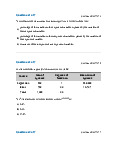

Preview text:
The Human Population Can Grow, Decline, or Remain Fairly Stable
Births > Death during a given period of time => Human population increase
Births < Death during a given period of time => Human population decrease
Human populations grow or decline through the interplay of three:births (fertility),
deaths (mortality), and migration
Population change = (Births + Immigration) – (Deaths + Emigration) (usually in 1 year)
Women Are Having Fewer Babies but the World’s Population Is Still Growing
Total fertility rate (TFR) – key factor affecting to human population growth &
size: the average number of babies born to a population's women in their reproductive years
Several Factors Affect Birth and Fertility Rates
the importance of children as a part of the labor force (most in less-develop
countries): many poor couples have many children who work for wages to help their families survive
the cost of raising and educating children (birth and fertility rates are lower in
more-developed countries): it takes a lot of money to raising children until they can
enter labor force in their late teens or twenties
The availability of, or lack of, private and public pension systems (especially the
poor in less-develop countries): pensions reduce a couple’s need to have several
children => can not replace who die at early age & support them in old age
Urbanization: better access to family planning services & have fewer children than rural areas
the educational and employment opportunities available for women: TFR low
when women have access education & work outside
Average age at marriage: have fewer children when average age of woman at marriage >= 25
the availability of legal abortions
The availability of reliable birth control methods: control and spacing of the children
Religious beliefs, traditions, and cultural norms >< abortion, forms of birth control
Several Factors Affect Death Rates
Life expectancy: the average length of the life of members of a group of people
infant mortality rate: the number of babies out of every 1,000 born who die before their first birthday
High infant mortality rate <= insufficient food, poor nutrition, high incidence of infectious disease
Low infant mortality rate, woman have fewer children => fewer children die at an early age
Migration Affects an Area’s Population Size
Migration: the movement of people into (immigration) and out of (emigration)
specific geographic areas => to seek job and economic improvement
However, it causes religious persecution, ethnic conflicts, political oppression, or war
environmental refugees: pp who have to leave their homes & countries <= lack of water or food, …




